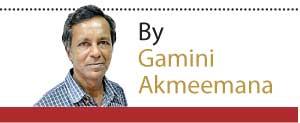27 Feb 2023 - {{hitsCtrl.values.hits}}
Those who burnt down Sujith’s paintings have no idea of the calibre of the man they attacked. This artist is someone who’d rather starve than compromise
People get involved in art in varying degrees. This is true of artists as well as the art appreciating public. I have met many artists who are committed to their art, making enormous sacrifices. But I haven’t met anyone as compulsive, and obsessed with his art as Sujith Ratnayake.
many artists who are committed to their art, making enormous sacrifices. But I haven’t met anyone as compulsive, and obsessed with his art as Sujith Ratnayake.
Stepping into the Lionel Wendt art gallery to see his exhibition was a sombre experience. Hanging on the white walls are frozen seas of harsh reds and ominous blacks, oil and acrylic in thick impasto on canvas. Form gets submerged in snarling, accusing colour as your nerves ask for reprieve.
But you get none. Dominating the interior space are two sizeable sculptures. The dark blue door of a police bus is used to make an artistic statement that is poised to strike your psyche the way a baton could be poised to strike your body. The rear view mirror shows a crowd of advancing protesters.
Then you move on to a recreation of a police remand cell. The devices used are simple – the familiar black iron cell door and huge mirror. The mirror is placed in front and reflects anyone standing behind the cell door, effectively locking them in. It’s an uneasy moment and the sculpture (or installation) becomes a poignant statement about the insecurity of the individual trying to retain their basic rights in a high militarized world which puts state security over citizens’ rights and freedoms.
The third item is a bleak iron bed (reminiscent of hospitals, prisons or torture chambers) with a crumpled shirt and trousers spread out in the shape of a human. There is no sign of torture, but the whole ambiance is shabby and repulsive. A pair of worn rubber slippers and a copy of the Lankan constitution lie on the floor. Has the occupant of these clothes, the owner of these slippers and the manual disappeared? Or is this all that’s left of him or her after what they have been through?
trousers spread out in the shape of a human. There is no sign of torture, but the whole ambiance is shabby and repulsive. A pair of worn rubber slippers and a copy of the Lankan constitution lie on the floor. Has the occupant of these clothes, the owner of these slippers and the manual disappeared? Or is this all that’s left of him or her after what they have been through?
All the paintings are on the theme of struggles waged by people of this country for their rights. Sujith Ratnayake is no stranger to such struggles. He ran his art gallery from a tent at Galle Face during a marathon 150 days last year during the Aragalaya. It was destroyed with all the artworks by goons when they stormed out of Temple Trees to attack a peaceful protest.
Those who burnt down Sujith’s paintings have no idea of the calibre of the man they attacked. This artist is someone who’d rather starve than compromise. When I interviewed him, not a single painting from this exhibit had been sold. But he has not done this focusing on sales. He’s happy making an artistic statement with no concessions made to what the public may or may not like.
His entire artistic life, starting in the 1990s, has not been focused on sales. He made one big sale to the Fukoka Asian Art Museum in Japan in 2000, and has spent the entire proceedings for his art, living in a half-finished house supported by his school teacher wife. That’s why I said at the start that I haven’t met anyone as compulsive, and obsessed with his art, as Sujith Ratnayake.
Sujith was born in Hungama in the south. His father was a local artist who earned a living making film cutouts and the like. Sujith learned about paint and techniques from his father. His introduction to modern art came from a teacher called Sarath Weerasinghe. He’s a graduate of the Institute of Aesthetic Studies where he formally studied sculpture and learnt painting on his own.
After working as a school teacher from 2005-10, he dedicated his entire life to creating art. In today’s Sri Lanka, where hyperinflation and a ruined economy makes a non-commercial artist’s life monumentally difficult, he is determined to speak out against perennial injustices in his unique capacity as a brave and independent artist.
10 Jan 2025 18 minute ago
10 Jan 2025 26 minute ago
10 Jan 2025 38 minute ago
10 Jan 2025 40 minute ago
10 Jan 2025 45 minute ago